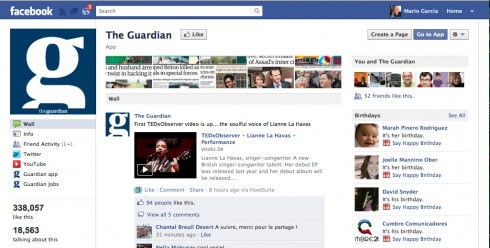This is the weekend edition of TheMarioBlog, and will be updated as needed. Next new blog is Monday, March 19
TAKEAWAY: It’s where the masses congregate, so if you want to sell your stuff while it is hot, or before it melts, go there, and seduce the audience to read you. The Guardian’s Facebook page is a textbook example of how to do it. What is the role of the newspaper’s social media editor?

They are coming to the Central Square. A good thing, and much needed and highly recommended.
The Central Square is my phrase for Facebook, Twitter and other social media networks. There is where the people congregate, so, as I often tell publishers, if you want to sell your churros while they are still hot, and your coconut glace before it melts, then you must go there, where the millions are gathering, and where you can strut your stuff to the masses: your best stories, the questions of the day, your best photos and videos.
The Guardian’s Facebook page is one of the best out there: inviting, provoking and, obviously, quite successful. The Guardian claims that five million people have already installed the Guardian’s Facebook app, which has added audio, video and photo galleries, as well as an updated homepage design since its debut in September 2011.
According to a Guardian story on the Facebook page:
“The updated homepage places a bigger emphasis on the social reading experience than before, and showcases the new articles, videos and galleries that have received the most attention in Facebook over the last few hours. We think this gives a vibrant and different take on the content that we publish, highlighting the stories that have caught the eye of Facebook users. Of course the editorially chosen news headlines are still there, as well as a space for our latest comment pieces.”
Other notables coming to the Central Square to sell their wares are El Pais, of Spain, The Daily, The Wall Street Journal and The Washington Post, all of which provoke and seduce with stories that lend themselves to interaction with the readers, usually posing a question of the day. And, in Germany, the financial daily, Handelsblatt, publishes a daily Morning Briefing on Facebook, via its editor in chief, Gabor Steingart
Getting to the Central Square
It is very appropriate to be discussing Facebook pages and newspapers at the end of a week that has had me discussing the very same topic in two active, energetic and with it newsrooms, the Goteborgs Posten (Sweden) and WirtschaftsBlatt (Austria).
In both cases, our workshops took us to a discussion of the role of social media for today’s daily newspapers.
There is no question that every newspaper needs to embrace social media, but to do it properly, someone in the team must be in charge. Give the task a name and a face to make it stick. Name a social media editor, full or part time. This is the person who will be the link between newspaper and the Central Square.
Our readers wish to engage with us, with the journalistic process. They no longer wish to be a passive audience, receiving information and not participating.
What are some specifics?
—The social media editor combs Facebook and Twitter, for example, for trends, ideas and issues of importance, to translate into stories..
—The social media editor establishes the newspaper’s Facebook page, a combination of what’s on the printed paper, the website, and, most importantly, a promotion of stories that pose questions/debate, teaser for blogs, videos, photos.
—The social media editor creates social media awareness within the team. I am always surprised the number of working journalists who do not participate in social media. It must be a requirement to do so. Part of the role of a good social media editor is to educate his/her peers.
—The social media editor brings Facebook/Twitter dialogs to the printed newspaper. There should be a daily box somewhere with information as to the most emailed articles, the pieces that have provoked the greatest commentary on Facebook or Twitter, and, of course, summaries of such debates for those readers who do not participate in the digital discussion. An issue is born on the Facebook page, but extends into the story or commentary on the editorial page.
I am always quite surprised when an editor tells me something like: Oh, that story on feminism generated 250 Tweets in a day.
Well, how nice, and why not tell the readers that tomorrow in the printed newspaper?
In my view, such social media networks as Facebook and Twitter were created to allow people to remind us in the professional media about the type of stories that matter to ordinary people, and that we often ignored.
We can’t afford to ignore those people and their stories anymore.
We do that only at our peril.
Our previous blog posts referring to the Central Square:
Breaking news and the people in the central square
https://garciamedia.com/blog/articles/breaking_news_and_the_people_in_the_central_square/
News agencies and social media: challenges of producing news when everyone’s a “journalist”
https://garciamedia.com/blog/articles/news_agencies_and_social_media_challenges_of_producing_news_when_everyones_/